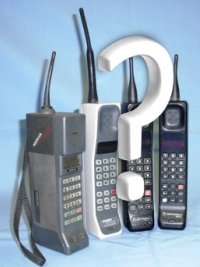The mobile phone was launched in the UK in 1985 and now, there are statistically more mobile phones in the country than people. There is no question that the mobile phone has had a tremendous and lasting impact on our lives. In many ways, more so than any other form of telecommunications technology. Can you imagine life without your smart phone that allows you to browse the web, download apps, send text messages, check your email, take photographs, play music, find out where you are using the built-in GPS receiver and, by the way, also make telephone calls? But how did it all begin and how has the mobile phone evolved from those early days of 1985 when a mobile phone was exactly that, a device for making telephone calls whilst outside? This section will trace that evolution from the walkie talkie to high performance smart phones.
Walkie Talkies, Car Telephones and Radio Pagers
The mobile phone owes its existence to the pioneering work of companies such as Motorola who created the walkie talkie which was one of the first portable communication devices. The success of the walkie talkie led on to the development of the car radio telephone and from there, the radiopager which was a very early form of one-way text messaging. Herewe review those technologies that were precursors to the mobile phone.
First Generation (1G) Analogue Mobiles
The mobile phone was the next logical development of both the car radio telephone service and personal mobile radios. For the UK, the first mobile phone networks were provided by Vodafone and Cellnet, both of which launched in January 1985. These first networks used analogue technology and the mobile handsets were very large, fairly heavy, had limited battery life and could only make telephone calls. Nevertheless, the mobile phone quickly established itself as an essential business tool and recognised part of everyday society. Today we look back on these early days and refer to the first generation of mobiles as the bricks!
Telepoint Services
Telepoint services were introduced to offer a more affordable solution for people who wanted some of the convenience of a mobile phone. However, Telepoint was a different technology to mobile phones. You could still make telephone calls whilst outside, but only if you were in range of a Telepoint access point. These access points were located in public spaces, on the high street, in railway stations and were indicated by easy to see signs. A significant problem, though, was that you couldn't receive calls when away from home. The UK introduced four Telepoint services but only one of these, Rabbit, achieved any real success. They were all short lived, having failed to compete with the second generation of digital mobile phones based on GSM.
Second Generation (2G) GSM Digital Mobiles
The mobile phone truly came of age with the launch of the second generation that used digital technology based on the new Groupe Special Mobile (GSM) standards. A move to digital technology also introduced new services such as SMS text messaging and the ability to access the Internet. Consequently, the mobile phone started to move away from being a device that could only make telephone calls and began to take on more and more computer style functions quickly leading to the emergence of the smart phone. New charging models based on pay as you go opened up mobile phone ownership to a greater cross-section of the population and manufacturers soon realised that the mobile had enormous potential as a fashion item.

Find a mobile phone (search our mobile phone database)
Are you looking for information about a specific mobile phone but don’t know whether it is within our collection or how we may have categorised it (1G, 2G etc.)?
Then use this “Find a mobile phone” function to search our mobile phone database and if there is an entry for the mobile phone you are looking for, you can access all of the information we have stored about it.
Follow on social media .....